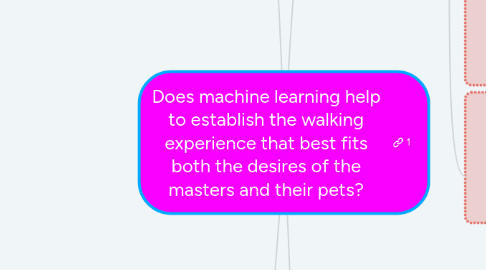
1. Machine learning/apprentissage automatique
1.1. deep learning
1.1.1. Neural Networks to Predict and Interpret Dog Behavior
1.2. predictive analysis
1.3. Need of Data
1.3.1. pedometer
1.3.1.1. Pedometer in the dog's leash or collar
1.3.1.1.1. analysis of breaks and detours to determine walker preferences
1.3.1.1.2. Analysis of the pace of walking
1.3.1.1.3. pause time analysis
1.3.1.1.4. analysis of places of breaks
1.3.2. wearable PET camera for brain imaging
1.3.2.1. gradual improvement of the walks according to the preferences of the animal
1.3.2.1.1. Avoid stressful situations
1.3.2.1.2. Promotes fulfilling situations
1.3.3. GPS tracking of the animal
1.3.3.1. Application to find the animal when it is lost
1.3.3.2. notification when the animal goes out of normal patterns of behavior
1.3.3.2.1. leak prevention
1.3.3.2.2. Reducing the mental burden of surveillance
1.3.3.3. Detects the presence of other animals with a GPS
1.4. Unsupervised learning
1.5. Supervised learning
2. social (human) experience
2.1. Connecting dog walkers who have the same passions
2.1.1. Walks between music lovers
2.1.1.1. Strolls with music as subject of conversation
2.1.1.2. walk punctuated by music
2.1.1.2.1. classical music walks
2.1.1.2.2. pop music walks
2.1.1.2.3. electronic music walks
2.1.2. Artists' walks
2.1.3. Student walks
2.1.4. Walks between sportsmen
2.1.4.1. bike rides
2.1.4.2. running trips
2.2. Meetings with animal friends
2.2.1. Friendly meetings between neighbors
2.2.2. Love dating
2.2.3. Meetings according to his displacements
2.2.4. Meetings with neighbors who have no animals but wish to invest
2.3. Organization of theme walks
2.3.1. Promenades turned to agility
2.3.2. Walks facing the water games
2.3.3. Sports walks
2.3.4. walks in the forest
3. Walking experience
3.1. Mixed reality, augmented reality and virtual reality
3.1.1. immersive outdoor augmented reality during pet walking
3.1.1.1. Immersive game
3.1.1.1.1. games mobilizing the external environment
3.1.1.1.2. games promoting moving outdoors
3.1.1.1.3. games involving the training of the animal
3.1.1.2. virtual walking companion
3.1.1.2.1. coach supervising sports outings
3.1.1.2.2. virtual companion establishing conversation on various topics
3.1.2. mixed reality in order to enhance the daily walking with new extraordinary things
3.2. smart can for blind people
3.2.1. Robotic dogs for the blind who adapt to the rhythm and habits of their masters
3.2.2. Information of blind people increased through the interpretation of the behavior of the " true " dog
4. walking pet experience
4.1. Sens of responsability
4.1.1. information about the needs of his pet
4.1.2. Notification and call back on time
4.2. Positive social pressure
4.2.1. dog pedometer collar
4.2.1.1. application locking the laptop until the turn is completed
4.2.1.2. notification in case of insufficiency
4.2.2. neighbors
4.2.2.1. SMS to neighbors in case of forgetfulness
4.2.3. veterinary
4.2.3.1. remote tracking of walking habits
4.2.3.1.1. automatic mail of reprimand t in case of recurrent insufficiency
4.2.3.1.2. Automatic mail of encouragement when habits are deemed sufficient
4.2.3.2. specialized advice
4.3. open space with pet-supportive features and pet-friendly destinations
4.3.1. Interactive map to locate the nearest spaces
4.3.1.1. pet coffee
4.3.1.2. special space
4.3.1.2.1. space without leash
4.3.1.2.2. paper garbage bags
4.3.2. Design environments that are supportive of dog walking

